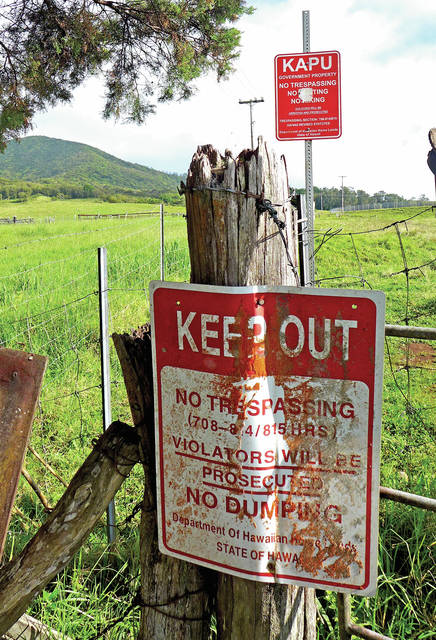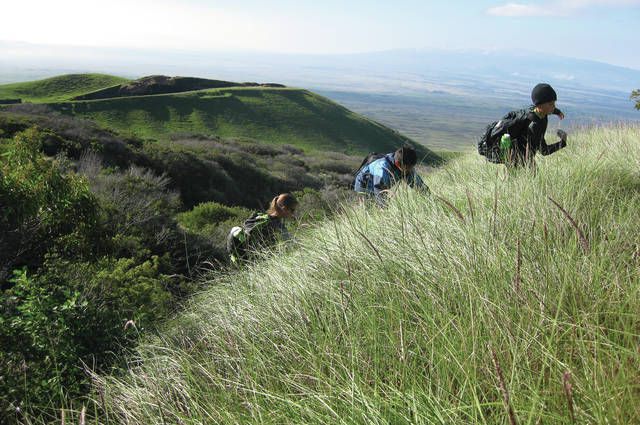KOHALA — North Kohala is where it all began. With lush rain forests and deep valleys, it is the oldest land on the island. Though some of the finest beaches and resorts are found in Kohala, much is still wild
KOHALA — North Kohala is where it all began. With lush rain forests and deep valleys, it is the oldest land on the island. Though some of the finest beaches and resorts are found in Kohala, much is still wild and undiscovered: an ardent hiker’s dream.
The valleys of Polulu and Waipio are two main attractions that are accessible. However, the hills more than a mile above the ocean — nearly 5,500 feet up Kohala Mountain — also call out to hikers. But much of this land is fenced or appears inaccessible. Visitors to Hawaii Island often are quick to note how much of the island remains fenced in.
With limited public access or hiking trails, friction between outdoor enthusiasts, land owners and land managers continues to be on the rise as more than a few individuals don’t pay heed to posted “No Trespassing” signs, fences are climbed over, or in some cases knocked down.
For 15 years, Kukuihaele Farms (K-Farms) has been running tours above Waipio Valley. The pressure continues to mount from people who question whose land it is and who should have access to it. Legally, K-Farms holds the lease from King Kamehameha Schools and Bishop Estates. As pristine as it is, it’s now a popular spot found in guidebooks and the Internet.
“Simply put, this is private land,” said K-Farms owner Richard Mastronardo.
Not private in the sense that no one is welcome, permission must be granted to tread on the land so the company isn’t held liable for mistakes made by trespassers. This year already, the police have had to intervene on several occasions.
Furthermore, some hikers who want to enjoy the outdoors are even willing to walk amidst hunters. Waimea resident Dean Honda, an avid hunter, questions why anyone would want to hike in areas where hunters are with dogs and guns. He suggests taking a hunter education course.
How hiking and hunting coexist
Offered through the Department of Land and Natural Resources, a hunting education course annually has 2,000 students, not always just hunters. Over the years, more than a handful of hikers have opted to take the course so they can have greater access to the outdoors.
Anyone over the age of 16 who is interested in conservation, safety and the responsible use of Hawaii’s natural resources can take the course. Children over 10 can also take it with an adult chaperone.
Instructors utilize lectures and videos over the 12-hour course that is stretched over two or three days. Participants can expect a written exam at the end. Earning a 75 percent or higher qualifies the graduate a hunting certification card and number. The certification does not expire and is recognized in all 50 states, Canadian provinces and Mexico.
Classes fill up quickly. The next one in North Hawaii is scheduled 5:30-10 p.m. June 19, 20 and 22 at the Waimea Hunter Education Building on Lalamilo Road. Interested participants can call 353-4868 to check availability and enroll.
Purely public access
Na Ala Hele is the State of Hawaii Trail and Access Program. Translated “trails to go on,” it was created in 1988 in response to public concern about the increasing loss of trails. Over the past 14 years Clement Chang Jr., a trails and access specialist, has worked hard to maintain popular trails like the Pololu Trail and the renowned nine-mile, one-way Muliwai Trail into Waimanu Valley.
“There is concern about the amount of people and usage,” he said.
However, Chang regards the best part of his job to be meeting people on the trail, “just enjoying being out in nature. Lots of trails here on Hawaii Island bring people from all over the world,” he added.
For hikers without the time or interest to take the hunter education course, there still are many options. A little lesser known reserve called The Puu O Umi Forest Reserve spreads over 10,000 acres. Here, the Kohala Watershed Partnership is working to restore the grassland back into the original native forest. A six-mile round-trip up Puu O Umi is possible without trespassing from the Kohala Mountain Road west of Waimea. The entrance is at the 5.6 mile post. This is the same location for a shorter hike at the 13-acre refuge of Koaia Tree Sanctuary.
Another alternative is to traverse the various sections of the 175-mile Ala Kahakai National Historic Trail. This starts at the northernmost point of Hawaii Island at Upolu Point. First used by Polynesians more than 1,500 years ago, the trail connects communities all along the coastline. This however is a hike for the more intrepid.
Yet another option, though at a cost, is to join a Hawaii Forest and Trail tour. The company steeped in 23 years of experience offers an eight-hour exclusive trip called Kohala Waterfalls Adventure.
Alternatives and opportunities for hiking in North Hawaii do exist. The hope is that people will continue to enjoy the beauty of the island but responsibly.




